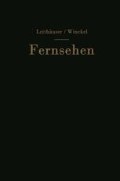Zusammenfassung
Die vielseitigen Probleme der Fernsehtechnik, welche zum großen Teil in den bekannten Aufgabenkreisen der Wissenschaft und Technik nicht enthalten sind, bedingen eine besondere Meßtechnik. Sie ist parallel zur Entwicklung des Fernsehens entstanden, hat aber mit dieser nicht Schritt halten können. Der Wunsch, schnell ein hochwertiges Fernsehbild zu gewinnen, hat die gesamte Entwicklungskapazität erfordert, so daß die meßtechnische Erfassung und die daraus resultierende exakte kritische Betrachtung etwas zurückstehen mußten. Der erstrebenswerte Zustand, daß die meßtechnischen Möglichkeiten um eine Größenordnung die technischen Anforderungen übertreffen, ist noch nicht voll erreicht worden.
Access this chapter
Tax calculation will be finalised at checkout
Purchases are for personal use only
Preview
Unable to display preview. Download preview PDF.
Literatur
Standards on Television: Methods of Measurement of Time of Rise, Pulse Width, and Pulse Timing of Video Pulses in Television, 1950. — Proc. Inst. Radio Engrs., N.Y. (1950), S. 1258 bis 1263.
Morrison, H. L. : Precision device for measurement of pulse width and pulse slope. RCA-Review (1947), S. 276 bis 288.
Page Burr, R.: The puke cross generator applied to television production test equipment. Tele Tech. (1949), S. 36 bis 39.
Standards on television: Methods of measurement of television signal levels, resolaution, and timing of video switsching systems, 1950. Proc. Inst. Radio Engrs., N.Y. (1950), S. 551 bis 561.
Mertz, P., u. F. Gray: A theory of scanning and its relation to the characteristics of the transmitted signal in telephotography and television. Bell Syst. techn. J. (1934), S. 464 bis 515.
Impulszentrale und Monoskopanlage. Radio-Mentor (1951), S. 440 bis 444.
Egidi, O. : Metodo di rilievo dell curve die selittiva di un rieevitori televiso. Rendiconti Li Tiunione Associatione Elettronica Nr. 140 (1950), S. 243 bis 247. Publicazione Istituto lettrotechnico Nazionale Galilei Ferraris, Nr. 277 (1950), 8 Abb.
Wagner, K. W.: Operatorenrechnung. J. A. Barth, 1940.
Legler, E. : Ein neuartiges Gerät zur Aufnahme ven Frequenzkurven, Hausmitteilungen der Fernseh-GmbH, Bd. 2 (1941), S. 50 bis 54.
Weis, A.: Das Magnetvariometer. Funk und Ton (1950), S. 508 bis 518 u. S. 559 bis 568.
Cormack, A. : Wide-range variablefrequency oscillator. Wireless Engr. (1951), S. 266.
Brown, C. B.: Methods of developing sweep and marker generator signals Radio and television news (1951), S. 48.
Clayton, R. J., D. C. Epsley, G. W. S. Griffith u. J. M. C. Pinkham: The London-Birmingham television radio-relay link. Proc. Inst. Electr. Engrs., Teil I (1951), S. 204 bis 223.
Dillenbttrger, W.: Ein neues Meßgerät zur Laufzeitmessung. Frequenz (1950), S. 10 bis 13.
Müller, J. : Die Bestimmung des Amplituden- und Phasenganges von linearen Übertragungssystemen mit Hilfe von Rechteckwellen. FTZ (1951), S. 211 bis 220.
Ginzton, E. L., W. R. Hewlett, I. H. Jasberg u. I. D. Noe; Distributed Amplification. Proc. Inst. Radio Engrs., N.Y. (1948), S. 956 bis 969.
Ring, D. H., u. A. C. Beck: Testing repeaters with circulated pulses. Proc. Inst. Radio Engrs., N.Y. (1947), S. 1226 bis 1230.
Cherry, C. : Pulses and Transients, London: Chapman & Hall Ltd. (1949).
Rasch, R., Rauschmessungen bei Fernsehübertragungen, FTZ (1952), S. 440 bis 444.
Author information
Authors and Affiliations
Editor information
Editors and Affiliations
Rights and permissions
Copyright information
© 1953 Springer-Verlag OHG., Berlin/Göttingen/Heidelberg
About this chapter
Cite this chapter
Schunack, J. (1953). Fernsehmeßtechnik. In: Leithäuser, G., Winckel, F. (eds) Fernsehen. Springer, Berlin, Heidelberg. https://doi.org/10.1007/978-3-642-92591-7_15
Download citation
DOI: https://doi.org/10.1007/978-3-642-92591-7_15
Publisher Name: Springer, Berlin, Heidelberg
Print ISBN: 978-3-642-92592-4
Online ISBN: 978-3-642-92591-7
eBook Packages: Springer Book Archive

